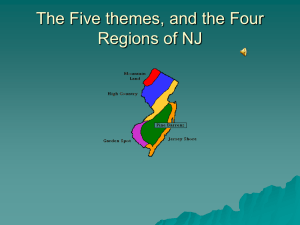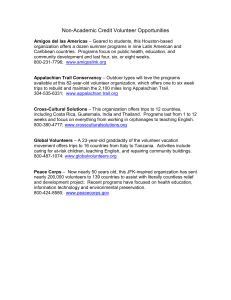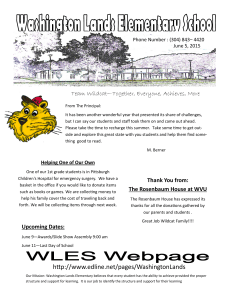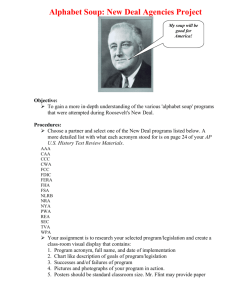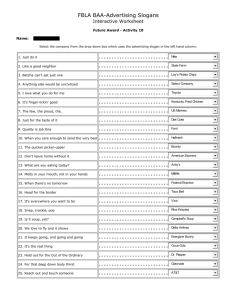The Mountain Heritage Center
advertisement
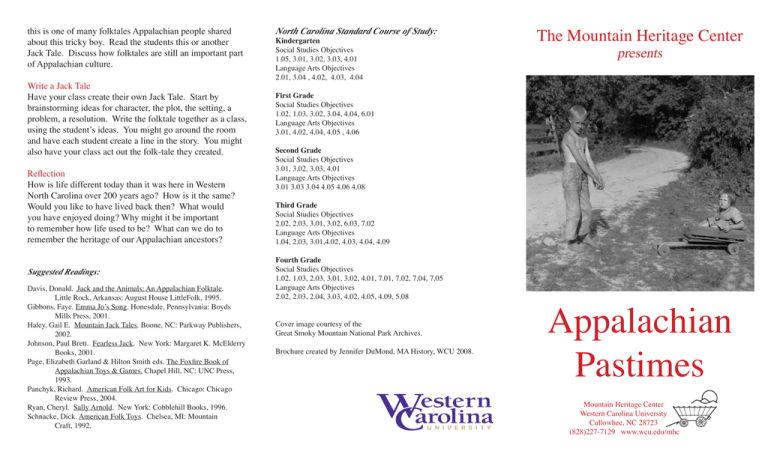
this is one of many folktales Appalachian people shared about this tricky boy. Read the students this or another Jack Tale. Discuss how folktales are still an important part of Appalachian culture. Write a Jack Tale Have your class create their own Jack Tale. Start by brainstorming ideas for character, the plot, the setting, a problem, a resolution. Write the folktale together as a class, using the student’s ideas. You might go around the room and have each student create a line in the story. You might also have your class act out the folk-tale they created. Reflection How is life different today than it was here in Western North Carolina over 200 years ago? How is it the same? Would you like to have lived back then? What would you have enjoyed doing? Why might it be important to remember how life used to be? What can we do to remember the heritage of our Appalachian ancestors? Suggested Readings: Davis, Donald. Jack and the Animals: An Appalachian Folktale. Little Rock, Arkansas: August House LittleFolk, 1995. Gibbons, Faye. Emma Jo’s Song. Honesdale, Pennsylvania: Boyds Mills Press, 2001. Haley, Gail E. Mountain Jack Tales. Boone, NC: Parkway Publishers, 2002. Johnson, Paul Brett. Fearless Jack. New York: Margaret K. McElderry Books, 2001. Page, Elizabeth Garland & Hilton Smith eds. The Foxfire Book of Appalachian Toys & Games. Chapel Hill, NC: UNC Press, 1993. Panchyk, Richard. American Folk Art for Kids. Chicago: Chicago Review Press, 2004. Ryan, Cheryl. Sally Arnold. New York: Cobblehill Books, 1996. Schnacke, Dick. American Folk Toys. Chelsea, MI: Mountain Craft, 1992. North Carolina Standard Course of Study: Kindergarten Social Studies Objectives 1.05, 3.01, 3.02, 3.03, 4.01 Language Arts Objectives 2.01, 3.04 , 4.02, 4.03, 4.04 The Mountain Heritage Center presents First Grade Social Studies Objectives 1.02, 1.03, 3.02, 3.04, 4.04, 6.01 Language Arts Objectives 3.01, 4.02, 4.04, 4.05 , 4.06 Second Grade Social Studies Objectives 3.01, 3.02, 3.03, 4.01 Language Arts Objectives 3.01 3.03 3.04 4.05 4.06 4.08 Third Grade Social Studies Objectives 2.02, 2.03, 3.01, 3.02, 6.03, 7.02 Language Arts Objectives 1.04, 2.03, 3.01,4.02, 4.03, 4.04, 4.09 Fourth Grade Social Studies Objectives 1.02, 1.03, 2.03, 3.01, 3.02, 4.01, 7.01, 7.02, 7.04, 7.05 Language Arts Objectives 2.02, 2.03, 2.04, 3.03, 4.02, 4.05, 4.09, 5.08 Cover image courtesy of the Great Smoky Mountain National Park Archives. Brochure created by Jennifer DuMond, MA History, WCU 2008. Appalachian Pastimes Mountain Heritage Center Western Carolina University Cullowhee, NC 28723 (828)227-7129 www.wcu.edu/mhc Appalachian Pastimes Dear Teacher: The following materials are provided for you to prepare your students for the Appalachian Pastimes outreach program from the Mountain Heritage Center. The students experience will be greatly enriched if they are introduced to some of the concepts of Appalachian history and folk life before our visit. We have also enclosed some potential followup activities you can use with your students to reinforce the lessons from the program. We look forward to your visit! Vocabulary Appalachia - A region of the eastern United States including the Appalachian Mountains. Folkways - A practice, custom, or belief shared by the members of a group as part of their common culture. Pastimes - Activities that occupy a person’s free time pleasantly ex: Sailing is her favorite pastime. Ancestors - A person from whom a person is descended, especially if more distant than a Grandparent; relatives who lived a long time ago. Folktales - Stories or legends forming part of an oral tradition. Heritage - Something that is passed down from earlier generations; a tradition. Culture - The total way of life shared by a group of people, including their customs, beliefs, arts, ways of thinking, living, working and relating together. Artifact - An object made or shaped by people. Discussion Ideas and Activities Pre-Visit Brainstorming Ask students to brainstorm a list of things they like to do for fun. Than ask students which of these pastimes they could not have done 200 years ago. Why couldn’t they have done some of the same things we do today? (No electricity, no cable, no movies, no cars, etc.) Go through and mark out these activities. Have students hypothesize what children might have done for fun instead with what they had available at the time. List the student’s suggestions. Looking at the list, have students think about what fun things people did 200 years ago that we still like to do today. Journaling Activity Have students each write a journal entry describing a day in their lives if they had lived 200 years ago. Encourage them to think about what chores they might have had to do, what they might have eaten, how the world might have looked, and how their lives would have been different without modern conveniences. What aspects of their lives might have been the same? Cross-Stitch Sampler Craft Often early pastimes were practical as well as fun. By making a cross-stitch sampler, children could practice their letters and numbers and learn how to sew. Materials: -markers -piece of needlework fabric (purchased from craft stores) -needlepoint yarn to match markers -large eye needlepoint needles for each student Have each student draw the letters A, B and C in a row on their fabric using different colored markers. Than have students draw the numbers 1, 2, and 3 in a second row beneath the letters. Leave at least a one-inch margin around the edges. Using one color of yarn at a time (to match the markers) have students thread the needle and sew over each letter and number making x shaped stitches. After each letter have students tie a knot in the yarn from behind. When they finish sewing over their numbers and letters they can sew a border around the edges and their initials in a corner. (From American Folk Art For Kids.) Soup Pot Game Play Soup Pot (also known as Stink Base and Prison) in any open area. There are no boundaries unless desired. Begin by choosing two equal teams. Mark the center of the open area into halves with a Dare line. Give each side a Safe Area or home base and a Soup Pot circle towards the back of that Safe Area. The object of the game is to run across the “dare” line into the opposing team’s territory without getting caught, and to tag members of the opposite team who dare to invade your territory. A player tagged by an opposing team is put in the Soup Pot. Team members can be rescued from the Soup Pot in two ways, either by a team member running to the Soup Pot and tagging his teammate (both still have to get back through the opposing teams territory to get to their Safe Area) or by running a complete circle around the opposing team’s Safe Area and Soup Pot to release all their teammates currently in the soup pot. Then everyone in the Soup Pot must get back to their own Safe Area without being tagged. (From The Foxfire Book of Appalachian Toys and Games.) Post Visit Toys What was your favorite toy in the presentation? Draw a picture of yourself playing with that toy. Read a Jack Tale Storytelling was a popular pastime in early Appalachia. Tales were popular stories about a boy named Jack. Ask the students if they know the story of Jack and the bean stalk. Tell them
